The Vampire Bat Blu-ray Movie
HomeThe Vampire Bat Blu-ray Movie 
Special Restored EditionThe Film Detective | 1933 | 63 min | Not rated | Apr 25, 2017
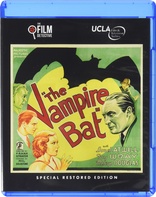
Movie rating
6.2 | / 10 |
Blu-ray rating
| Users | 0.0 | |
| Reviewer | 3.0 | |
| Overall | 3.0 |
Overview
The Vampire Bat (1933)
When the villagers of Klineschloss start dying of blood loss, the town fathers suspect an outbreak of vampirism. While police inspector Brettschneider remains skeptical, scientist Dr. von Niemann cares for the victims one by one. Meanwhile, suspicion falls on simple-minded Herman Gleib because of his fondness for bats.
Starring: Lionel Atwill, Fay Wray, Melvyn Douglas, Maude Eburne, George E. StoneDirector: Frank R. Strayer
| Horror | Uncertain |
| Sci-Fi | Uncertain |
| Drama | Uncertain |
| Romance | Uncertain |
| Mystery | Uncertain |
Specifications
Video
Video codec: MPEG-4 AVC
Video resolution: 1080p
Aspect ratio: 1.37:1
Original aspect ratio: 1.37:1
Audio
English: DTS-HD Master Audio 2.0 Mono (48kHz, 24-bit)
Subtitles
English SDH
Discs
Blu-ray Disc
Single disc (1 BD)
Playback
Region A (B, C untested)
Review
Rating summary
| Movie | 2.0 | |
| Video | 4.0 | |
| Audio | 2.5 | |
| Extras | 2.5 | |
| Overall | 3.0 |
The Vampire Bat Blu-ray Movie Review
The Torches Burn Brightly
Reviewed by Michael Reuben April 23, 2017The latest public domain release from The Film Detective is The Vampire Bat, the 1933 effort by second-string studio Majestic Pictures to cash in on the horror bonanza inaugurated by Universal Studios with Frankenstein and Dracula. The disc is notable for the involvement of the UCLA Film & Restoration Archive, which has overseen the film's restoration from surviving elements, including the re-creation of rarely seen hand-painting that added splashes of color to one sequence on a few black-and-white release prints.
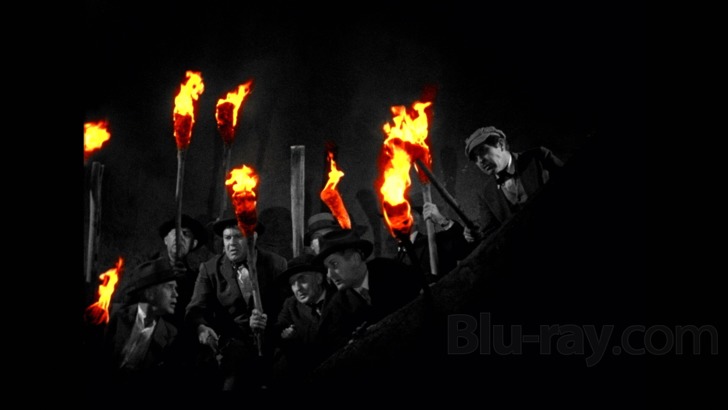
A mysterious killer is stalking the streets of Kleinschloss, a generically European village in an unspecified time. (It looks exactly like the village in Frankenstein, because the film was shot on the same Universal backlot.) The townspeople and Bürgermeister Gustave Schoen (Lionel Belmore) fear that a vampire is hunting them, because the victims bear telltale puncture wounds and are drained of blood. Their concerns are supported by the local doctor, Otto von Niemann (Lionel Atwill), who describes cases of vampirism reported by explorers of distant lands, but the resident police detective, Karl Brettschneider (Melvyn Douglas), dismisses these theories as nonsense. Nevertheless, suspicious eyes begin to focus on Herman Gleib, the town weirdo who is obsessed with bats. (If he reminds you of Dracula's Renfield, that's probably because he's played by the same actor, Dwight Frye.) Several more victims are claimed by the mysterious killer before his identity is discovered and his true nature revealed. Meanwhile, the local hypochondriac, Gussie Schnappmann (Maude Eburne), provides comic relief, while her pretty niece, Ruth Bertin (Fay Wray), supplies a love interest for detective Karl and a damsel-in-distress for the film's climax.
The Vampire Bat rises above its status as a horror knockoff thanks to an eminent cast led by Douglas, who was a genuine movie star and an accomplished performer, later winning Oscars for Hud and Being There. Wray would shortly enter film history as the beauty who kills the beast in King Kong, and she and Atwill had recently co-starred in Mystery of the Wax Museum, which was being heavily promoted when Majestic Pictures rushed Vampire Bat into theaters to capitalize on their notoriety. Atwill, of course, was already familiar to audiences from the previous year's Doctor X, and he would shortly become even better known as a villain in Captain Blood and a dart-playing police chief in Son of Frankenstein. But it's veteran character actor Maude Eburne who steals the show as Aunt Gussie, blithely mangling medical terminology as she assigns herself one mortal condition after another with the boundless energy of someone with an iron constitution who's never been sick in her life.
The Vampire Bat Blu-ray Movie, Video Quality 
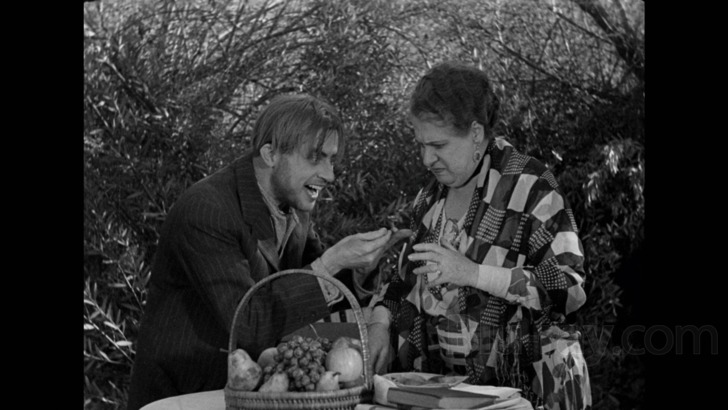
The Vampire Bat was shot by Ira S. Morgan, who would later serve as Charlie Chaplin's
cinematographer on Modern Times. To create this new
master for The Film Detective's 1080p,
AVC-encoded BD-R, the UCLA Film & Restoration Archive has drawn from several different
prints of varying quality (and with different styles of "cigarette burn" markers). Even with
UCLA's efforts, visible damage remains in the form of scratches and an occasional missing
frame. On the whole, however, this presentation of the film is such a vast improvement on
previous video releases that fans should be delighted. The original photography is somewhat
inconsistent, with interiors shot on well-lit sound stages typically displaying the best clarity,
sharpness, detail and contrast, while exteriors shot at night on the Universal backlot or on nearby
locations appear muddier and less distinct. (A few inserts of stock footage look even worse.)
By far the most impressive achievement of this Blu-ray presentation is the sequence just over
halfway into the film, where a mob of villagers chase the unfortunate Herman Gleib through a
canyon and into a cave. The digital colorist has shaded the townspeople's torches with bright
yellow and orange flames in an effort to replicate the hand-painting applied to a few original
release prints. The contrast between the brightness of the flames and the black-and-white
surroundings creates a memorably surreal effect, endowing the sequence with an eerie but
beautiful foreboding. Contemporary audiences must have been dazzled.
The Film Detective has been faulted for using BD-Rs instead of pressed Blu-rays, but no one can
accuse them of skimping on bitrates. The Vampire Bat has been authored with a high average rate
of 35 Mbps and a capable encode. In rating the disc's video, I have taken into account the
problematic source, so that this Blu-ray has received a higher rating than would be assigned to a
release from a major studio with comparable flaws. PD presentations have to be graded on a
curve.
The Vampire Bat Blu-ray Movie, Audio Quality 

The mono soundtrack, encoded in lossless DTS-HD MA 2.0, has presumably been sourced from
optical track(s) of the various prints used for the restoration. Digital cleanup has been performed,
but the results have been oddly assembled. Whenever there is dialogue or a sound effect, it is
accompanied by audible background hiss such as one expects to encounter on tracks of this
vintage, even after filtering and noise reduction. But when the soundtrack contains nothing, the
hiss disappears, replaced by dead silence. Sometimes the silence lasts so long that one might be
forgiven for wondering whether the audio processor has shut off. No doubt the engineers were
instructed to minimize background noise, but they have taken their assignment too literally. The
proper approach for a soundtrack of this nature is to establish a consistent level of background
noise, to which the ear adjusts and the listener subjectively tunes out. But by intercutting periods
of dead silence, the engineers have effectively emphasized background hiss whenever it returns,
constantly reminding the listener of unwanted interference. The effect may not bother everyone,
but I found it distracting.
The Vampire Bat has only two music cues, which were supplied from stock sources. Their
fidelity is what one would expect from a low-budget film from this era.
The Vampire Bat Blu-ray Movie, Special Features and Extras 
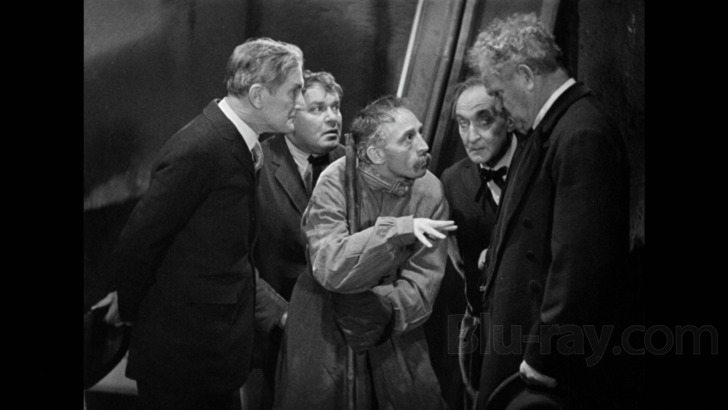
- Commentary with Sam Sherman: Sherman is a writer, producer, director and the founder of Independent-International Pictures, a distributor of genre cinema. His commentary is a rambling chat, more personal memoir than film history or analysis, and much of it is only tangentially related to The Vampire Bat.
- Original Featurette: Becoming the Son of Melvyn Douglas (1080p; 1.78:1; 7:03): In a poignant and revealing interview, Douglas' eldest son, Gregory Hesselberg, shares memories of his famous father.
The Vampire Bat Blu-ray Movie, Overall Score and Recommendation 
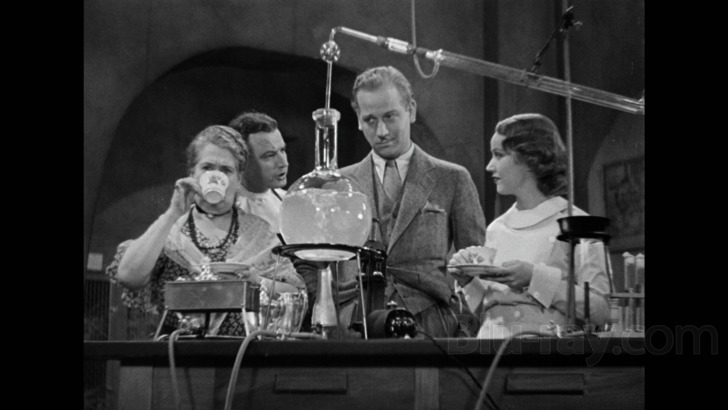
The Vampire Bat isn't in the same league as Universal's horror classics, but it's a superior "B"
picture with several memorable performances and an inventive mash-up of elements lifted from
other films (I can't be more specific without spoilers). The Film Detective and the UCLA
Archive has freshened the film beyond anything one usually sees with a PD property.
As long as you're not bothered by distribution on BD-R, the disc is recommended.
Similar titles
Similar titles you might also like

The Return of Dracula
The Fantastic Disappearing Man / Curse of Dracula
1958

Summer of 84
2018

Mad Love
Warner Archive Collection
1935

The Cat and the Canary
Standard Edition | Masters of Cinema
1927

The Bride of Frankenstein 4K
1935

The Black Phone
Collector's Edition
2021

The Invisible Man 4K
1933

Tales of Halloween
2015

Mark of the Vampire
Warner Archive Collection
1935

Firestarter
Collector's Edition
2022

Freaks
2018

Dance of the Damned
1989

Kiss of the Damned
2012

The Devil Doll
Warner Archive Collection
1936

Return of the Fly
1959

The Hunchback of Notre Dame
1923

House of Dark Shadows
1970

Doctor X
Warner Archive Collection
1932

Brightburn
2019

Flatliners
2017
